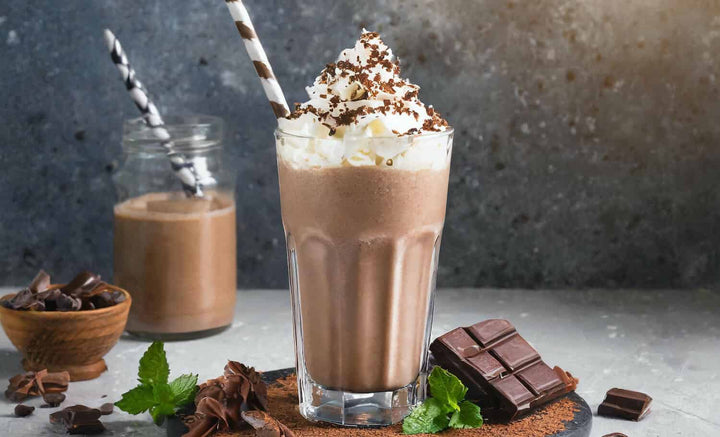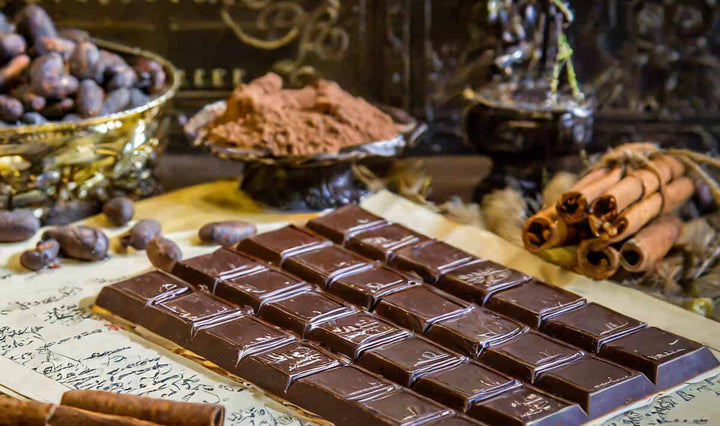In the world of chocolate, the bean-to-bar movement represents a return to the roots of chocolate making, emphasising quality, craftsmanship, and a deep connection to the source.
This artisanal approach to chocolate production has gained significant traction among connoisseurs and ethical consumers alike, offering a transparent journey from the cocoa bean in its rawest form to the final chocolate bar savoured by enthusiasts around the globe.
What is Bean to Bar Chocolate?
Bean-to-bar chocolate refers to a process and philosophy within the chocolate-making industry.
The chocolate maker controls every stage of the production process, from sourcing the cocoa beans to producing the final chocolate bar.
This approach is distinguished by its emphasis on quality, transparency, and direct involvement in every step of the chocolate creation, from the bean selection to the bar.
Key Aspects of Bean-to-Bar Chocolate:
-
Sourcing: Bean-to-bar chocolate makers often source their cocoa beans directly from cocoa farmers or through fair trade organisations, focusing on ethical practices and sustainability. This direct sourcing allows chocolatiers to ensure the quality of their beans and support sustainable farming practices.
-
Roasting: Each batch of beans is carefully roasted to develop its unique flavour profile. The roasting process is crucial, significantly affecting the chocolate's final taste. Bean-to-bar producers experiment with roasting times and temperatures to bring out the best in each bean.
-
Grinding and Refining: The beans are ground into cocoa liquor after roasting. This process also involves refining, where the particle size of the cocoa is reduced, and additional ingredients like sugar and sometimes cocoa butter are added to achieve the desired texture and flavour.
-
Conching: This step involves heating and mixing the chocolate over several hours to days. Conching improves the texture and flavour of the chocolate, making it smoother and removing any unwanted acidic tones.
-
Tempering and Molding: The chocolate is then tempered, carefully heating and cooling to stabilise the cocoa butter crystals, resulting in a shiny finish and a crisp snap. Finally, the chocolate is poured into moulds to set before being packaged.
Why Bean-to-Bar Matters:
The bean-to-bar movement is significant for several reasons:
- Quality and Flavour: By controlling the entire process, makers can ensure high-quality production standards and develop unique flavour profiles that reflect the origin of the beans.
- Transparency and Ethics: Bean-to-bar chocolate often has a higher level of transparency regarding where and how the cocoa beans were sourced, focusing on ethical and sustainable practices.
- Innovation: This approach allows chocolate makers to experiment with different bean varieties, roasting techniques, and recipes, contributing to a diverse and innovative chocolate market.
Bean-to-bar chocolate represents a product and a commitment to quality, sustainability, and the art of chocolate making.
It offers consumers a deeper understanding and appreciation of chocolate, from the nuanced flavours of different cocoa origins to the ethical considerations of production.
For those passionate about chocolate, bean-to-bar offers a pure, enriching experience that connects them directly to the source of their favourite treat.

How is Chocolate Made From Start to Finish?
The journey of chocolate from bean to bar is a fascinating process that combines art, science, and tradition.
It involves several key steps, each crucial to developing the chocolate's final flavour, texture, and quality. Here's an overview of how chocolate is made from start to finish:
1. Harvesting
The process begins with harvesting cacao pods, the cacao tree's fruit (Theobroma cacao).
Workers manually cut the pods from the trees using machetes, typically in countries within 20 degrees north and south of the Equator, where the climate suits cacao cultivation.
2. Fermenting
Once harvested, the pods are opened to extract the cacao beans, surrounded by a sweet, pulpy substance.
These beans are then fermented for about five to seven days, a crucial step that develops the beans' flavour.
Fermentation occurs in large containers or on the ground, where the beans are covered with banana leaves.
3. Drying
After fermentation, the beans are spread out to dry under the sun.
Drying reduces the moisture content of the beans, stopping the fermentation process and making them suitable for storage and transport.
This step also continues to influence the beans' flavour development.
4. Roasting
Upon reaching the chocolate manufacturing facility, the dried beans are roasted.
Roasting temperatures and times vary, but this step is essential for enhancing the chocolate flavour, reducing bitterness, and killing any remaining bacteria.
After roasting, the beans are cracked open to remove the outer shells, leaving behind the cacao nibs.
5. Grinding
The cacao nibs are ground into a paste called chocolate liquor or cocoa mass.
This process generates heat, which melts the cocoa butter in the nibs, resulting in a liquid form of chocolate.
6. Conching
The chocolate liquor undergoes conching, continuously mixed and aerated in a conche (a type of machine).
Conching can last several hours or days, depending on the desired quality.
This process develops the final flavour and texture by reducing bitterness and acidity and smoothing the chocolate.
7. Tempering
Tempering is a method of carefully heating and then cooling the chocolate to stabilise the cocoa butter crystals.
This process ensures that the finished chocolate is glossy, snaps when broken, and melts smoothly in the mouth.
8. Molding and Cooling
After tempering, the chocolate is poured into moulds to give it its final shape, whether bars, chips, or other forms.
The chocolate is then cooled, allowing it to solidify.
9. Packaging
Once cooled and solidified, the chocolate is removed from the moulds, wrapped, and packaged for sale.
10. Enjoyment
The final step, arguably the most rewarding, is the enjoyment of the chocolate by consumers, who can appreciate the complex flavours and textures resulting from this intricate process.
From the tropical cacao tree to the finished bar, chocolate making is a craft that requires precision, care, and a deep understanding of the raw materials involved.
Each step in the process contributes to the unique characteristics of the final product, offering a world of flavours and experiences for chocolate lovers to explore.

Is Bean to Bar Chocolate Better?
Whether bean-to-bar chocolate is "better" than other types of chocolate is complex and doesn't have a straightforward answer.
This is because the perceived superiority of bean-to-bar chocolate often comes from its artisanal approach, direct source transparency, and emphasis on quality and sustainability.
However, these attributes do not inherently make bean-to-bar chocolate superior in every context or to every consumer.
The key factors that should define the quality and appeal of chocolate include the care taken in sourcing ingredients, the sustainability of production methods, and the health aspects of the final product.
Quality of Ingredients
One of the primary considerations in making high-quality chocolate, whether bean-to-bar or not, is the selection of ingredients.
Bean-to-bar manufacturers often have direct relationships with cocoa farmers, allowing them to select the finest cocoa beans and ensure they are grown and harvested under optimal conditions.
However, larger or non-bean-to-bar manufacturers can also source high-quality beans and ingredients, focusing on ethical and sustainable practices.
The difference lies in the transparency and control over the entire process, which bean-to-bar offers, but this does not necessarily guarantee a better product in every case.
Health Considerations
From a health perspective, the benefits of chocolate, particularly dark chocolate, are well-documented, including its antioxidant properties and potential to improve cardiovascular health.
Bean-to-bar chocolates often have a higher cocoa content and less added sugar, which aligns with healthier eating principles.
Nevertheless, other manufacturers can produce similarly health-conscious products by carefully formulating their recipes and choosing quality ingredients.
Sustainability
Sustainability is another crucial aspect of chocolate production.
Bean-to-bar chocolate makers typically emphasise ethical sourcing and environmental stewardship, directly impacting cocoa farmers' livelihoods and farming practices.
This approach promotes sustainability within the industry.
However, a commitment to sustainability isn't exclusive to bean-to-bar producers.
Many larger companies are increasingly adopting sustainable practices, such as participating in fair trade programs and implementing measures to reduce their environmental footprint.
What is the History of Bean to Bar Chocolate?
The "bean to bar" chocolate movement, emerging prominently in the early 21st century, focuses on the artisanal process where chocolatiers oversee every step of chocolate making, from sourcing the cocoa beans to producing the final chocolate bar.
This approach aims to enhance quality, ethical sourcing, and sustainability, marking a significant shift from traditional mass-produced chocolate practices.
Why is Bean to Bar So Expensive?
Bean-to-bar chocolate tends to be more expensive due to its artisanal and ethical production processes.
This approach involves sourcing high-quality cocoa beans directly from farmers, often paying above-market rates to ensure fair compensation.
The meticulous attention to each step of the chocolate-making process, from roasting to grinding to tempering, requires significant time and expertise.
Additionally, many bean-to-bar chocolatiers prioritize organic and sustainable farming practices, which can increase production costs.
Combining these factors results in a premium product that reflects its higher production standards and ethical considerations, justifying the higher price point than mass-produced chocolate.
Where Can You Buy Tasty Chocolate?
Whitakers Chocolates, renowned for our long history in crafting delicious and affordable chocolates, offers a range of options suitable for everyone, including vegetarian, vegan, and gluten-free choices.
Our top-selling products, such as indulgent Coffee Creams, Neapolitans, Chocolate Wafer Thins, Stem Ginger and Luxury Chocolate Truffles, are perfect for enhancing your mocha coffee experience.
Click here to see our full range of delicious chocolates…
Some Notes From an Expert Chocolatier
Working within the chocolate industry has been incredibly rewarding and filled with challenges and delights.
One of the aspects I enjoy most is the endless opportunity for creativity and innovation.
Chocolate, as a medium, is versatile, allowing for a vast spectrum of flavours, textures, and forms.
Transforming a cocoa bean into a piece of chocolate never ceases to amaze me.
My passion for chocolate goes beyond its pleasures.
The deep connection with the cocoa farmers, the communities, and the land enriches this profession.
That, to me, is the heart of why I love working in the chocolate industry.
Final Notes On Bean-to-Bar Chocolate
The bean-to-bar chocolate movement represents a profound shift in how we perceive, produce, and enjoy chocolate.
It embodies artisanship, ethical practices, and a deep-rooted respect for the raw materials and the people behind them.
This movement has not only introduced consumers to cocoa's rich, varied flavours from different regions.
Still, it has also highlighted the importance of sustainability, direct trade, and the welfare of cocoa farmers.
Bean-to-bar chocolate is more than just a product; it's a statement about quality, ethics, and the pursuit of excellence.











